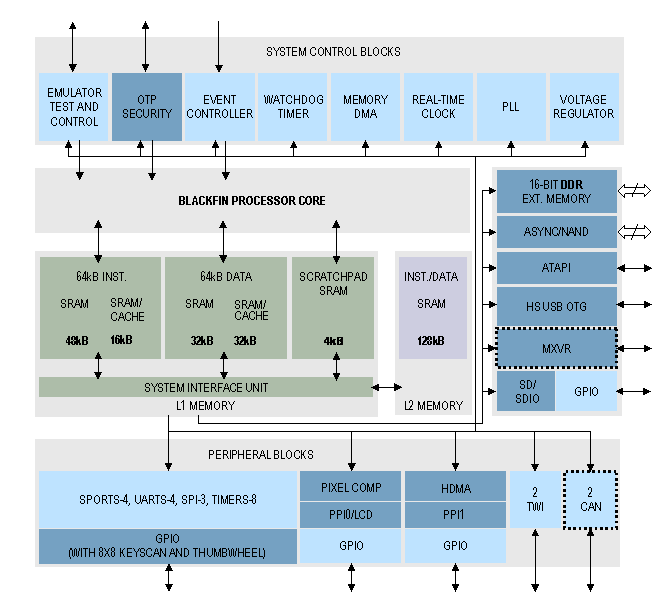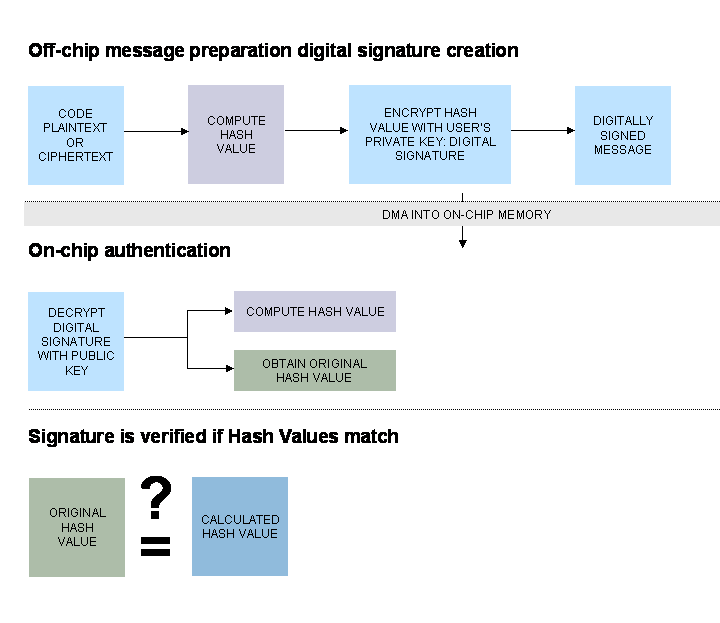This week, Analog Devices introduced four new members of its Blackfin processor family: the ADSP-BF549, ‘BF548, ‘BF544, and ‘BF542. These new devices will operate at clock speeds of up to 600 MHz and are intended mainly for automotive applications that incorporate signal processing, such as digital broadcast radio receivers, navigation systems, and rear-seat entertainment equipment.
The new devices feature more on-chip memory than most Blackfin devices (only the high-performance ‘BF535 and dual-core ‘BF561 have more). The highest-performance new devices, the ‘BF548 and ‘BF549, feature up to 260 Kbytes of L1 and L2 SRAM and 64 Kbytes of factory-programmed L1 ROM. ADI has also increased both on-chip and off-chip memory bandwidth by adding a 32-bit DMA controller to the 16-bit DMA controller present in earlier single core devices, and doubling the external bus width of the external memory controller from 16 to 32-bits. The two DMA engines on the chip are connected to both L1 memory and the external memory controller, allowing data from the peripherals to be fed to the processor core or external memory. Another noticeable change is the addition of a video coprocessor that can be programmed to accelerate color-space conversion, alpha blending, and overlay generation. These new features will give the processors a significant performance boost in applications requiring video processing. Figure 1 shows the main blocks in the ‘BF548 and ‘BF549 chips.

Figure 1. Block Diagram of the ‘BF548 and ‘BF549 Chips.
Dashed lines indicate peripherals only supported in automotive versions of the chips
Another added feature is ADI’s new “Lockbox” technology, a combination of software and hardware that facilitates the implementation of security protocols for applications such as digital rights management, software authentication, and theft protection. The technology relies on a public key/private key encryption system enabled by a public key stored in a block of one-time-programmable memory and encryption software stored in factory-programmed ROM. Software authentication can be used to ensure that only programs released by the system designer are run on the system. To accomplish this, programs are signed with a digital signature created off-line (e.g., on a host PC) using the private key known only to the creator of the file. The digital signature contains an encrypted hash value that characterizes the original program. When the digitally signed file is loaded onto the chip, the signature is decrypted and the hash value is verified in order to confirm that the program is authentic. Figure 2 below depicts the authentication process.

Figure 2. Block Diagram of Authentication Process
Texas Instruments also announced four new devices this week targeting many of the same applications as the new Blackfin devices. The devices, part of TI’s video-oriented DaVinci family, will also operate at clock speeds of up to 600 MHz and be offered at comparable price points (the new DaVinci chips are priced at $10-23, the new Blackfin chips at $12-19). The new DaVinci parts feature a high-performance C64x+ DSP core and coprocessors to accelerate common video processing tasks. BDTI estimates that the higher signal-processing throughput of the C64x+ core relative to the Blackfin core, and the presence of more extensive hardware acceleration, will give the DaVinci devices a performance edge for many video applications. The new Blackfin devices will offer more video processing capability than previous Blackfin parts due to the increased on-chip memory, increased memory bandwidth, and the added video coprocessor. ADI’s “Lockbox” technology may appeal to designers of products requiring IP protection. Another notable difference is that the Blackfin devices include support for the MOST protocol, whereas the DaVinci parts do not. MOST, or Media-Oriented System Transport, is a standard for transferring multimedia data that has seen success in Europe but has not been widely adopted by US and Japanese carmakers.
The new Blackfin devices are scheduled for sampling in the first quarter of 2007, with full production expected in the third quarter of 2007. Quantity 10,000 prices range from $11.95 for the 400 MHz ‘BF542 to $18.58 for the 533 MHz ‘BF549.


Add new comment